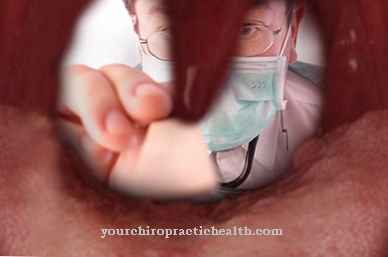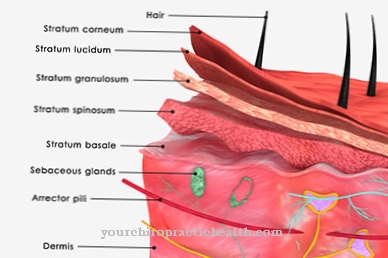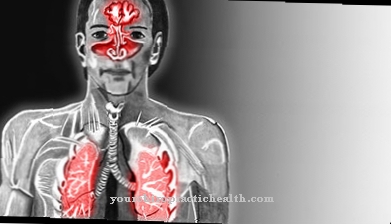A Tendonitis (tendovaginitis) or Tendinitis is an inflammation of the tendons in the tissue. Tendonitis often develops in the wrist, as the hands are used in many ways through work and sport and are therefore overloaded. But even simple activities such as writing, playing computer games and working on the computer can lead to tendinitis in the long term.
What is tendonitis?

At a Tendinitis it is a complete overstimulation of the tendons which occurs with great pain potential in the arm that is mainly used. For a right-handed person it is the right arm and vice versa. In the event of overexertion, tendinitis can also occur in one leg.
Tendonitis is a very painful inflammation of the musculoskeletal system. It can usually only be cured by rigorous immobilization of the affected body part. However, as long as the affected part of the body begins to tremble as soon as it is used, tendonitis is by no means cured. If the pain of the tendinitis persists, the same applies of course.
causes
The Tendinitis usually arises from massive and persistent overexertion. Tendonitis can arise from frequent crocheting and knitting or other handicrafts as well as after hours of typing on a keyboard. Writing with a classic pen, which tends to be cramped, can also lead to tendinitis.
The same applies to relatively monotonous activities such as plastering walls or sawing wood. Last but not least, tennis very often leads to tendinitis due to incorrect posture of the racket. This is where the erroneous but widespread term "tennis elbow" for tendinitis comes from. Basically, every movement that tends to be the same and that is repeated over and over again can lead to very painful tendinitis due to incorrect posture or too few breaks and relaxation phases.
Tendonitis can only be cured with absolute calm and lasting recovery. So it makes sense to take regular breaks before even tendinitis develops.
Symptoms, ailments & signs
Tendonitis causes pain in the affected tendons that is described as pulling. The affected joints hurt with every movement. Initially, the pain is only noticeable when moving or under strain. Later on, the joints can be very painful and throbbing even when they are at rest.
Redness and swelling may appear in the affected joints. The skin also feels warmed up. If tendinitis occurs on the forearm, grinding noises can occur when moving. These friction noises are known as snowball crunching. Tendonitis can also be seen visually.
Then a small bump will appear under the skin. This is due to the congestion of the parallel tendon fibers. You may also feel numb. The wrists are most commonly affected. The disease can also affect the elbows or ankles. If the inflammation is not treated, scarring leads to thickening and knotting and the tendons to stick together.
If rheumatism proves to be the cause of the disease, deformed joints become apparent. The disease is associated with severe pain, but usually subsides after a few days without complications. If left untreated, a chronic course is possible and the patient can feel pain for months.
Complications
In most cases, tendinitis takes a favorable course. However, there is a risk of complications if the disease is recognized and treated too late. So it is possible that the inflammation takes a chronic course.
Some chronic forms of tendinitis are so complicated that even medical treatment cannot provide adequate relief. If a connection between illness and workplace is established, an occupational disease can even be recognized. In such cases, patients are forced to switch to other tools or to take up a new job.
For some sufferers, psychotherapeutic treatments are necessary due to the illness. If the tendinitis takes a chronic course, medicine is also referred to as RSI (Repetitive Strain Injury). This clinical picture is caused by the same stresses that are repeated over and over again.
If the tendinitis shows up on the hand or the flexor tendon sheaths, this can result in a snapping finger. Doctors then also speak of tendovaginitis stenosans. During this process, the tendon sheaths, which belong to the flexor muscles of the fingers, are thickened. The metacarpophalangeal joint, located on the inside of the hand, is particularly affected by such thickening.
If the tendinitis has to be treated surgically, there is also a risk of complications. These primarily include accidental damage to the nerves, the growth of a nerve in the scar tissue, and inflammation of the surgical wound.
When should you go to the doctor?
Tendonitis must always be examined and treated by a doctor. Only with proper medical treatment can further complications be prevented. If the tendonitis is not treated, the inflammation can, in the worst case, spread. A doctor should be consulted if the person concerned is suffering from very severe pain. These pains mainly occur when the patient is in a resting position and increases with movement. Often, the pain of tendinitis spreads to the neighboring regions and leads to considerable discomfort there as well.
Furthermore, it is not uncommon for severe reddening or swelling of the area to point to the tendinitis. Numbness can also indicate the disease. The pain lasts for a long time and does not go away on its own. In the case of tendinitis, a general practitioner can primarily be seen. Further treatment is then carried out by a specialist.
Treatment & Therapy
Usually in the event that a Tendinitis was diagnosed, a cast was put on. The aim of this is to prevent any form of strain as long as the tendonitis persists. Tendonitis can be treated supportively with radiation and often even calmed down a bit. If this treatment method is indicated, a plaster splint can be made instead of the closed plaster and put on again after each treatment.
Splints made of lighter plastics are just as often used to immobilize the arm during tendinitis but still be able to carry out direct radiation. In addition, soothing ointments that relax the diseased tendons and provide warmth are administered.
Regular light massage of the affected parts of the body with these ointments also alleviates the pain caused by tendonitis. A tendonitis that has not healed before the body part is again stressed is, so to speak, on the go: it will be noticeable again immediately. It is imperative that you seek medical advice before resuming exercise or work.
You can find your medication here
➔ Medicines for muscle painprevention
To one Tendinitis To prevent this, it can be very useful, for example, to strengthen the muscles in the arm, the use of which is excessively required, with a so-called hand expander.
This measure should, however, be started at the earliest when the tendinitis that has already occurred has definitely healed. Another form of tendinitis prevention is to properly learn a trade or sport from a professional or trainer. Only correctly learning the required movements can prevent the arm from being used incorrectly. This would inevitably lead to a possible renewed tendinitis within a very short time.
Aftercare
In most cases, patients with tendinitis have no special or direct options and measures for follow-up care available, so that a doctor should be consulted at an early stage in the event of this disease. Therefore, a doctor should be contacted at the first signs and symptoms of tendinitis in order to prevent other complaints and complications from occurring.
No independent healing can occur, so that those affected are always dependent on a medical examination and treatment. In many cases, the symptoms can be relieved with the help of medication. The person concerned should always pay attention to regular intake and the prescribed dosage in order to permanently alleviate the symptoms.
A doctor should also be consulted first if anything is unclear or if you have any questions. Those affected should rest and take care of their bodies, but refrain from exertion or stressful activities.In the case of tendinitis, the help and support of one's own family can also be very useful in order to make everyday life easier for the person affected. As a rule, the patient's life expectancy is not restricted by the disease.
You can do that yourself
It is crucial to keep the inflamed area still for several days and to protect the limbs. If the tendinitis occurs in the hand, for example, the other hand should be used more intensively. After a few days, the affected hand can be carefully accustomed to stress again.
It is good practice to apply coolant or ice. These are to be wrapped in a towel so that they do not lie directly on the skin. Otherwise they would cause reactions in the skin that would be similar to those of a burn. It also makes sense to apply a pain reliever and anti-inflammatory ointment several times a day, which can be bought over the counter in pharmacies and drug stores. Depending on where the tendinitis occurs, the area may then be bandaged. Corresponding painkillers can be taken if the pain is severe. If the tendinitis does not improve even after days, it is advisable to consult a doctor.
In everyday life, the cause of tendinitis should be researched and, if necessary, behavior and other conditions should be changed so that it does not recur: For example, a flatter PC keyboard helps to relieve the tendons of those who write a lot, and more breaks should be taken when playing the piano or knitting .

















.jpg)







.jpg)


